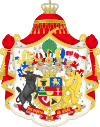Duke Ernest Gottlob of Mecklenburg
| Duke Ernest Gottlob of Mecklenburg | |
|---|---|
Johann Zoffany, c. 1772 | |
| Born | 27 August 1742 Mirow, Mecklenburg-Strelitz |
| Died | 27 January 1814 (aged 71) |
| House | Mecklenburg-Strelitz |
| Father | Duke Charles Louis Frederick of Mecklenburg |
| Mother | Princess Elisabeth Albertine of Saxe-Hildburghausen |
Duke Ernest Gottlob Albert of Mecklenburg (27 August 1742 – 27 January 1814) was a member of the
Mary Eleanor Bowes
.
Enormous debt would later lead Ernest to attempt another marriage with a princess from the
George IV
.
Life
Johann Zoffany, c. 1771–72.[1]
Ernest Gottlob Albert was the seventh child and third son of
George III of the United Kingdom in 1761, and Ernest followed her to London.[2]
Ernest was described by novelist
Adolphus Frederick IV, Duke of Mecklenburg. However, King George III disallowed the marriage, as he disapproved of his brother-in-law marrying someone not of royal blood.[2] Charlotte Papendiek, Queen Charlotte's wardrobe keeper, wrote many years later that the match would "have made him a Prince indeed; but as he was a younger brother, it might have disturbed the harmony of the house of Mecklenburg-Strelitz."[4][5] Ernest does not appear in Mary's letters, and it does not seem likely that his affection was reciprocated.[6]

In late 1768 at Queen's House (now
Charles, Ernest benefited from Charlotte's marriage and gained promotion within the Hanoverian Army, of which George III was the head.[10] Ernest eventually became the military governor of Celle, in Hanover, where he welcomed George III's exiled sister Queen Caroline Matilda upon the end of her marriage to Christian VII of Denmark.[9][11][12]
In 1782 Ernest attempted to enter into a marriage with a princess from the
House of Holstein-Gottorp in an effort to pay his numerous debts. However, both the fact that he was a third son and the uncle of a male heir limited his appeal to potential dynastic alliances. Charlotte advised her brother to drop the match, as the dowry of the princess in question would not be enough to settle his debts; furthermore, neither she nor her husband would be able to help with his finances. She hoped that Christian VII of Denmark would provide a large dowry, as the princess was a member of his house, but concluded that no one would blame Ernest if he stopped pursuing the marriage. This frank advice was later praised by their brother Charles,[13] and Ernest never married.[10]
He died on 27 January 1814 at the age of 71.
Honours
Ancestry
| Ancestors of Duke Ernest Gottlob of Mecklenburg Countess Amalia Katharina of Waldeck-Eisenberg | | |||||||||||||||
|---|---|---|---|---|---|---|---|---|---|---|---|---|---|---|---|---|
| 31. Countess Maria Magdalena of Nassau-Siegen | ||||||||||||||||
Sources
- Grewolls, Grete (2011). Wer war wer in Mecklenburg und Vorpommern. Das Personenlexikon (in German). Rostock: Hinstorff Verlag. p. 2580. ISBN 978-3-356-01301-6.
References
- ^ "Queen Charlotte with her children and brothers". Royal Collection. Archived from the original on 24 September 2012. Retrieved 29 August 2011.
- ^ a b c d Moore, p. 38.
- ^ Moore, p. 30.
- ^ Papendick, p. 75.
- ^ Moore, pp. 38–39.
- ^ Moore, p. 39.
- ^ Papendick, p. 41.
- ^ Urban, p. 85.
- ^ a b Black, p. 312.
- ^ a b Campbell Orr, p. 369.
- ^ Campbell Orr, p. 381.
- ^ Wilkins, pp. 229, 242-243, 245.
- ^ Campbell Orr, p. 376.
- ISBN 0-7200-0344-X.
- ^ Genealogie ascendante jusqu'au quatrieme degre inclusivement de tous les Rois et Princes de maisons souveraines de l'Europe actuellement vivans [Genealogy up to the fourth degree inclusive of all the Kings and Princes of sovereign houses of Europe currently living] (in French). Bourdeaux: Frederic Guillaume Birnstiel. 1768. p. 84.
Bibliography
- ISBN 0-300-11732-9.
- Campbell Orr, Clarissa (2004). "Charlotte of Mecklenburg-Strelitz, Queen of Great Britain and Electress of Hanover: Northern Dynasties and the Northern Republic of Letters". In Campbell Orr, Clarissa (ed.). Queenship in Europe 1660-1815: The Role of the Consort. Cambridge University Press. pp. 368–402. ISBN 0-521-81422-7.
- Moore, Wendy (2009). Wedlock: The True Story of the Disastrous Marriage and Remarkable Divorce of Mary Eleanor Bowes, Countess of Strathmore. New York: Three Rivers Press.
- ISBN 1-143-96208-7.
- Urban, Sylvanus (1852). The gentleman's magazine, Volume 37. London: J.B. Nichols and Son.
- ISBN 1-153-93838-3.

